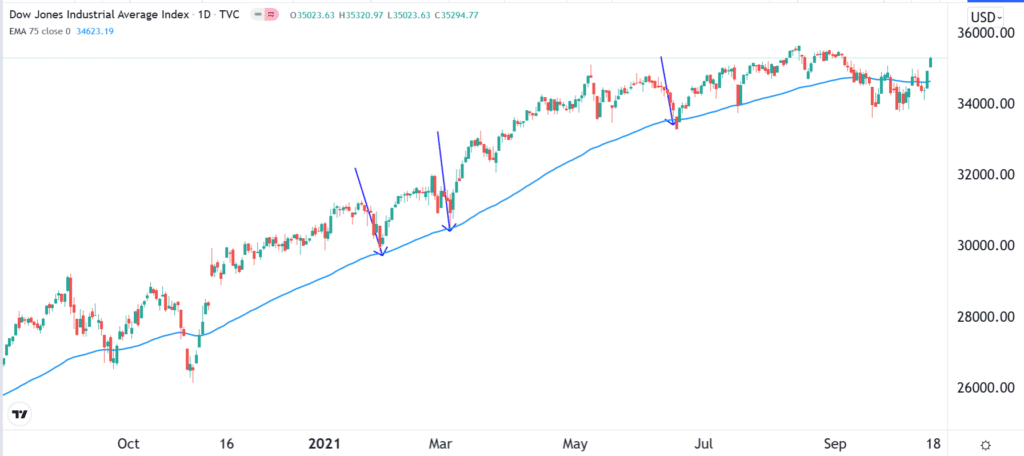
Timing the market is a trading or investing strategy where participants seek to buy assets when the price declines or short when the price rises. Time in the market, on the other hand, is the idea of buying an asset and hoping that it will keep rising in the longer term. People who use the latter strategy don’t care much about the short-term fluctuations of the asset. In this article, we will look at the difference between the two and the better option to use.
What is timing the market, and how does it work?
Timing the market is where you buy an asset like currency pair, commodity, or stock after it makes a major move. You can also short it when you think that it has moved up so quickly. For example, in early 2021, during the Wall Street Bets craze, one could have timed the market by shorting stocks like AMC and Blackberry when their stock prices surged.
There are several strategies you could use to time the market. Most people use their instincts where they feel that an asset has gone to an extreme level. For example, if you are trading Brent crude oil and its price moves from $80 to $83 in a session, you could decide to short it. By so doing, you will be hoping that the price will drop. Similarly, you could have shorted Bitcoin when its price surged to its all-time high of near $65,000.
The second popular strategy of timing the market is using technical indicators like Moving Averages, Donchian Channels, and the Relative Strength Index (RSI).
In the chart below, we see that the Dow Jones index has been in a strong bullish trend for a while. But this uptrend has not been a smooth one. There are times when the index has fallen by as much as 10% within a few days. Therefore, if you use the 75-day Moving Average, you could have bought the dips when the price tested the average.

Third, you could use charting tools like the Fibonacci retracement and Andrews Pitchfork to time the market. These tools have several lines that are based on different calculations. The Fibonacci retracement is based on the Fibonacci sequence. As such, you could place a buy trade when an asset’s price moves to the 50% Fibonacci retracement level. If it struggles to move below the level, it increases the possibility that it will resume the upward trend.
Fourth, market timers use continuation and reversal chart patterns to determine entry and exit points. Examples of continuation patterns are ascending and descending triangles, bullish and bearish flags, cup and handle, bullish and bearish pennants, and some forms of triangles. Reversal patterns are wedges, head and shoulder patterns, and double top and bottom. When these patterns happen, market timers can predict what will happen next.
Another popular approach to market timing is to use harmonic patterns like the ABCD, XABCD, BAT, Gartley, Crab, and Butterfly patterns. In addition to these, market timers also use thematic strategies like the Elliott Wave and the Wyckoff model to predict the direction of the asset.
Time in the market as the fundamentals-driven approach
Time in the market is an investment approach where the participant is not concerned with the day’s price action of the asset. Instead, they are only interested in buying an asset they believe will rise in the long term, and short one they expect will fall.
In most cases, people who use the time in the market strategy are concerned about the market fundamentals. For example, in stocks, they look at several things, including:
- The broader theme in the market – For example, one can invest in a stock like Tesla since they believe that electric cars are the future. Similarly, one could invest in a stock like Amazon if they believe that e-commerce and cloud computing is the future.
- Corporate earnings – They can buy stocks that they believe will experience substantial growth in earnings over time.
- Monetary policy – People using time in the market could also be thinking about monetary policy. For example, they could believe that interest rates will remain low for more time.
- Country growth – For forex traders using time in the market strategy, they could buy a currency if they believe that a country’s economy will be able to sustain the growth.
- Commodity cycles – Another fundamental approach is where they believe that a commodity cycle is coming and buy assets like crude oil and copper.
Timing the market vs time in the market
There has been a debate about which is better between timing the market and time in the market. On the one hand, some market participants who are long-term investors have been against timing the market. They believe that it is an impossible task to do.
On the other hand, most people who are market timers believe in the power of short-termism. They believe that one can make better returns when timing the market than when buying and holding assets.
In reality, there are pros and cons to the two approaches. Indeed, many people using the two approaches have made a fortune. For example, Warren Buffett has more than six decades in the industry using time in the market. On the other hand, a billionaire like Jim Simmons has been successful by timing the market.
Each of these strategies has its pros and cons. For example, when you time the market, it is possible to identify better entry points. On the other hand, when you use time in the market strategy, you can misjudge some thesis. For example, you can judge that a central bank will remain hawkish only for it to become dovish. Therefore, what is needed is to test and backtest the strategy for a sufficient time.
Summary
Time in the market and timing the market are two approaches you can use to make money in the financial market. In this article, we have looked at what they are, some of the strategies, and their pros and cons.








Leave a Reply